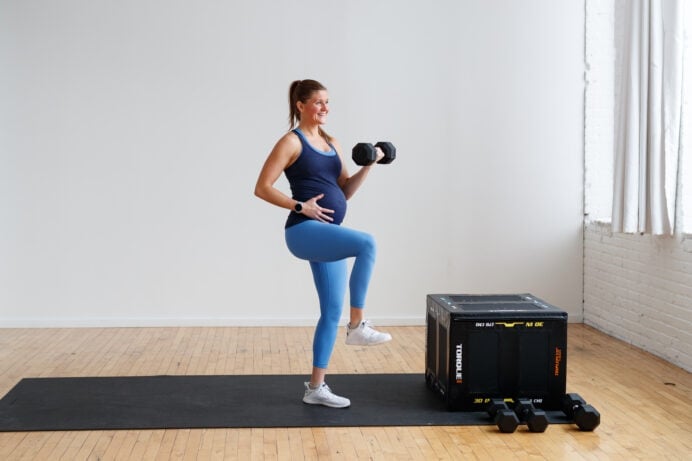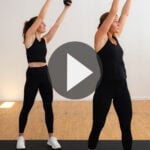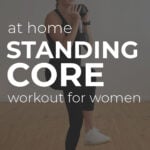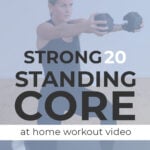

20-Minute Standing Core Workout With Weights (Strong 20, Day 4)
Strength train your abs with this quick and effective workout: Standing Core Workout with Weights! Build core stability by training in multiple planes of motion, targeting your abs from all angles. No boring crunches here.
This is DAY FOUR of our Strong 20 Program.
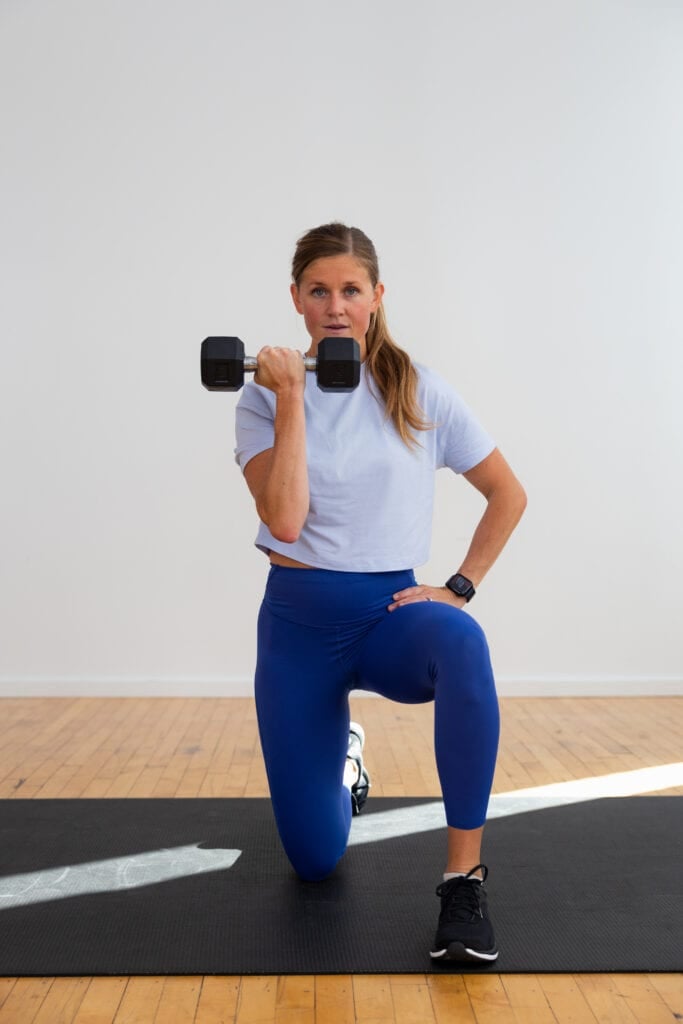
LET’S GET STARTED
Download Your FREE Strong 20 Workout Plan
Want a stronger and more defined core? It’s time to start strength training your abs.
The fourth day of our Functional Strength Training Program adds weights to standing ab exercises, targeting every muscle between your shoulders and your pelvis.
This core workout prioritizes movement patterns you use in your daily life: pivots, twists, uneven weight carry and weight transfers, and balance work.
These movements show up in many of our daily tasks, such as unloading a dishwasher, carrying a baby on your hip, or reaching for something on the top shelf.
Today’s workout trains the core from all angles and from different planes of motion, resulting in increased core strength, better coordination and stability and reduced risk of injury.

Core Workout with Weights FAQs
The muscles that make up the core benefit from strength training, just like any other muscle group. Adding weights to core exercises increases the intensity of the workout and builds muscle in the abs.
Training your core with weights increases both the muscle strength and total body stability. By adding a weight to core exercises, we are able to practice building strength and stability in a controlled setting.
Most people think of the rectus abdominis, or “six-pack” muscles when they think of the core, but it’s so much more than that. The core also includes the obliques (sides of your body), erector spinae, pelvic floor, transverse abdominis (or deep, corset-like ab muscles), diaphragm and the glutes.
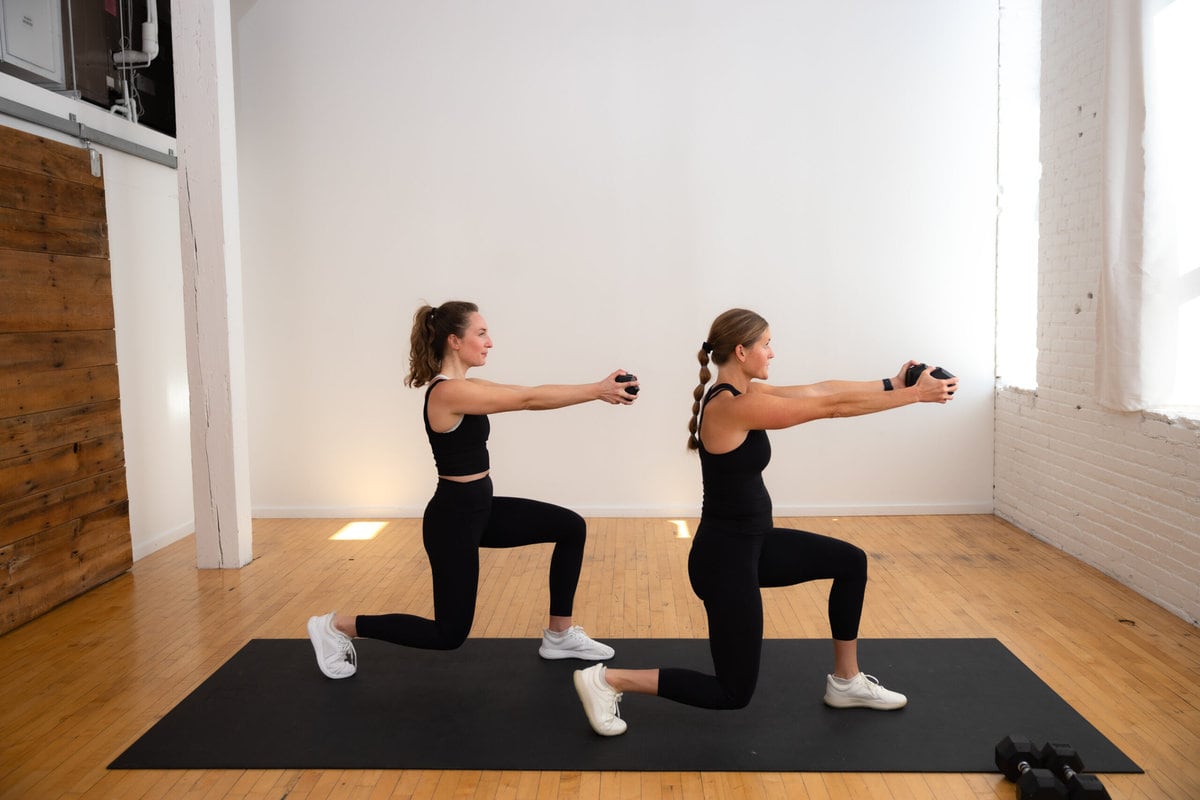
20-Minute Standing Core Workout with Weights (Strong 20, Day 4)
Strengthen the abs from all angles with this Standing Core Workout With Weights.
This functional strength workout combines the best standing core exercises to target the muscles that support and stabilize your body through all your daily movements.
I suggest doing this standing core workout once a week as part of a well-rounded workout routine.
Workout Equipment:
One medium-to-heavy dumbbell.
I recommend 8-30 lbs depending on your fitness level. We’re using 15-20 lb dumbbells in this workout. The last 2-3 reps of each exercise should be challenging to complete with good form.
Shop My Extra-Large Yoga Mat
DISCOUNT CODE: NourishMoveLove
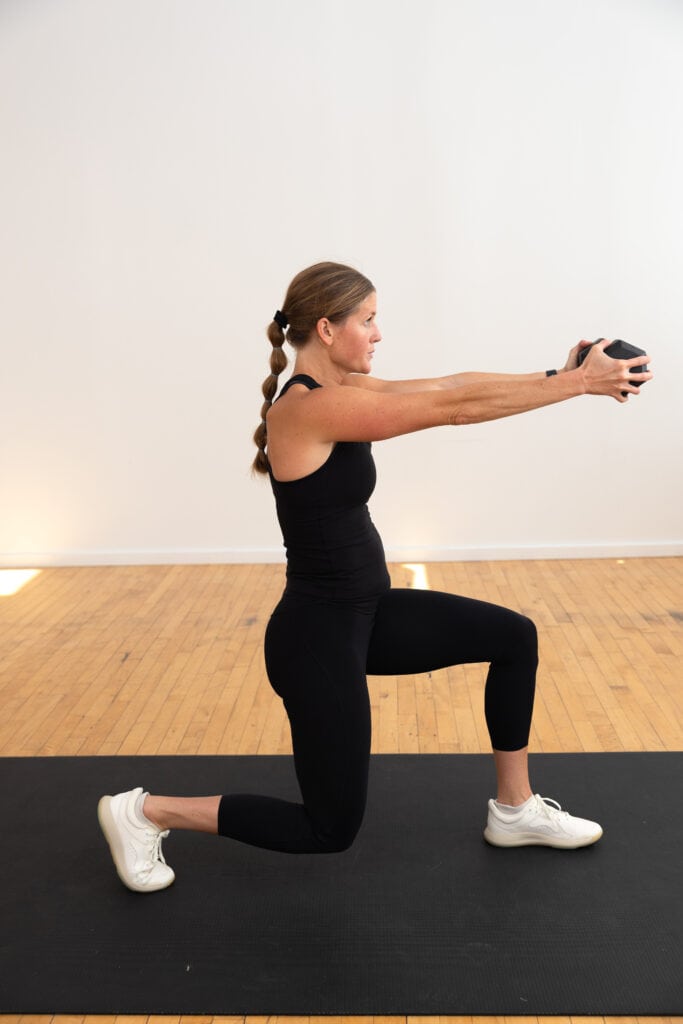
Workout Instructions:
Follow along with the guided Standing Core Workout With Weights on YouTube, led by certified personal trainer and fitness instructor, Lindsey Bomgren.
Your Workout Looks Like This:
- 12 Standing Core Exercises With Weights
- Timed Intervals (30 seconds work, 10 seconds rest. Complete as many reps as you can in the timed interval)
- Perform Each Exercise x2 (back-to-back, then move on to the next exercise)
Workout Outline
- Goblet Hold March
- Front Lunge, Dumbbell Press Out, Knee Drive and Overhead Press (Right)
- Front Lunge, Dumbbell Press Out, Knee Drive and Overhead Press (Left)
- Single Leg Deadlift and Dumbbell Pass (Right)
- Single Leg Deadlift and Dumbbell Pass (Left)
- Diagonal Lift (Right)
- Diagonal Lift (Left)
- Alternating Lateral Lunge and Halo
- Rotational Lunge and Press (Right)
- Rotational Lunge and Press (Left)
- Snatch and Overhead March (Right)
- Snatch and Overhead March (Left)

Prefer to Watch On YouTube?
7 Best Standing Core Exercises With Weights
Goblet Hold March
Targets: Low abs, obliques, glutes, hip flexors, chest and shoulders.
The farther you hold the dumbbell out away from your body, the harder your core will have to work.

How To Do A Goblet Hold March
- Start in a standing position, feet hip-width apart, holding a dumbbell vertically at your chest, elbows tucked in.
- Engage your core, then drive your right knee up in line with your right hip. Right knee bent at a 90-degree angle.
- Ground through your standing left leg for stability, then return your right foot back to the ground.
- Switch sides, driving your left knee up in line with your left hip. Return to starting position and repeat these alternating high knee lifts.
Front Lunge, Dumbbell Press Out, Knee Drive and Overhead Press
Targets: Legs, glutes, quads, hamstrings, hips, core muscles and shoulders.
Pressing the weight away from your body both horizontally and vertically challenges your core from all angles. Add in the knee drive for extra balance work and core engagement.

How To Do A Front Lunge, Dumbbell Press Out, Knee Drive and Overhead Press
- Start standing, feet hip shoulder width apart. Hold a dumbbell horizontally between your hands at shoulder height.
- Step your left foot forward into a front lunge, bending both knees at 90 degrees and lowering until your left thigh is parallel to the floor.
- Hold this low lunge position, then exhale as you press the dumbbell away from your body, keeping it in line with your shoulders. With control, pull it back in, holding it at your collarbones.
- Then, drive off your front heel to reverse the movement, pushing to standing while simultaneously driving your left knee up, balancing on your right foot. Left thigh is parallel to the ground.
- Hold this balance position, then press the dumbbell overhead, keeping wrists in line with shoulders.
- With control, lower the dumbbell to chest height, and step your left foot forward into a front lunge, returning to starting position.
Modification: replace the knee drive with a toe tap.
Single Leg Deadlift and Dumbbell Pass
Targets: Deep transverse abdominals, obliques, lower abs, upper abs, low back, hamstrings and glutes.

How To Do A Single Leg Deadlift and Dumbbell Pass
- Start standing with feet spaced hip-width apart, right leg forward, left toe popped slightly behind the right leg. Most of your weight should be in your standing right leg.
- Hold a dumbbell in your left hand, and stand tall with a flat back and neutral spine.
- With your right knee bent, hinge at your hips (hip flexors), extending the left leg behind you as you balance on your right leg. Keep your hips even, square to the mat, as you press them back towards the wall behind you.
- Once you’ve reached the bottom (range of motion looks different for everyone), transfer the dumbbell in a circle around your leg, passing it to your right hand, then back to your left hand.
- Then, press through your right heel to stand tall, returning to standing. As you stand, drive your left knee up, so your left thigh is parallel to the mat.
- Pass the dumbbell in a circle around your floating left thigh, from left hand to right hand, and back to left hand again.
- Hinge forward, extending your left leg behind you to return to starting position.
Modification: Perform a staggered deadlift rather than a single leg deadlift by keeping your opposite toes on the ground.
Diagonal Lift
Targets: The deep transversus abdominis muscles, oblique muscles, hips, back, shoulders and core.
This weighted ab exercise trains the upper and lower obliques along the sides of the body, which provide stability for reaching motions.

How To Do A Diagonal Lift
- Start in a standing position, knees under hips, core engaged.
- Hold one dumbbell horizontally between your hands. Bring the dumbbell to the outside of your left hip.
- Then exhale as you use your abs and obliques to drive the dumbbell crossbody, extending your arms up overhead on the right side. Think left hip to chest to right shoulder.
- Lower the dumbbell with control back, first bringing it back to your chest, then lowering it to your left hip, returning to starting position.
Lateral Lunge and Halo
Targets: Gluteus medius (the outer part of your butt used for side-to-side movements), quads, hamstrings, hip adductors and abductors, core and shoulders.
This is also a great exercise to increase shoulder mobility.

How To Do A Lateral Lunge and Halo
- Stand with your feet under hips, holding a dumbbell horizontally between both hands.
- Step your right leg out to the side as you push your hips back, bending your right knee while leaving your left leg straight. Think of performing a single leg squat with your right leg while your left leg remains straight. Knees and toes are pointing forward.
- Then, drive off your right foot to reverse the movement, exploding back up to center and returning to standing.
- From this standing position, perform a dumbbell “halo”, bracing your core as you pull the dumbbell in a smooth motion from your chest to left shoulder and then behind and around your head, before bringing it down to your chest again.
- Then step out with your left foot to perform another lateral lunge, this time on the let side. Bend your left knee while keeping your right leg straight.
- Then drive off your left foot to push back to standing, performing another “dumbbell halo” from a standing position.
Modification: Follow the modifier on the left, substituting a bicep curl for the dumbbell halo.
Rotational Lunge and Press
Targets: Legs, glutes, quads, hamstrings, hip adductors, knee and ankle joints, lower back, shoulders and core.
The rotational lunge (or cossack squat) improves hip, knee, and ankle mobility. It also increases flexibility in the hamstrings and adductors (inner thighs).

How To Do A Rotational Lunge and Press
- Start standing in a neutral position, feet hip-width apart. Hold one dumbbell in your right hand, palm facing in towards your body, at your right shoulder.
- Step your right foot back, rotating your right toes and both hips 90 degrees to face the right wall. Left toes stay facing the front of the room.
- Bend your right knee and sit back towards your right hip, keeping your left leg straight. Think about performing a single leg squat on the right side. Left toes pop off the mat (toes up towards the ceiling).
- Then, drive off your bent right leg to reverse the movement, standing tall and facing the front of the room. As you stand, press the dumbbell in your right hand overhead, rotating your palm to face out away from your body. Dumbbell is stacked over your right shoulder.
- Return the dumbbell to your right shoulder, palm facing in, and repeat.
Snatch and Overhead March
Targets: Legs, hamstrings, hips, glutes, back, shoulders and deep transverse abdomen muscles (core).
The single arm dumbbell snatch is a compound exercise that works the full body and improves coordination, explosiveness and strength.
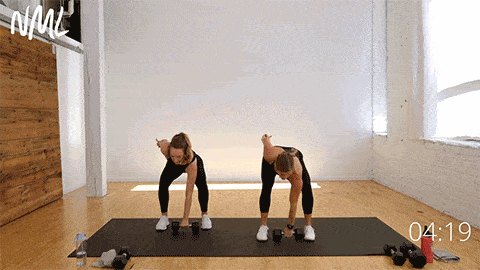
How To Do A Snatch and Overhead March
- Start standing, feet shoulder-width apart, knees slightly bent. Hold one dumbbell in your right hand at your side (palm facing in).
- Hinge forward at the hips, pushing your hips back as you lower the dumbbell down the front of your body. You should feel a stretch in the back of your legs (hamstrings).
- Then, drive your hips forward as you ‘snatch’ the weight overhead with your right arm (using the power and momentum created by your legs and hips). You should finish standing tall with your right arm straight overhead; lock out your elbow.
- While holding the dumbbell overhead, perform two knee drives, first lifting your right knee so that your right thigh is parallel to the ground, then repeating with the left knee.
- Then plant both feet on the ground and with control, slowly lower the dumbbell back down to shoulder height.

Strong 20: FREE Functional Strength Training Workout Plan
A 2-week, functional training program designed to help you feel stronger and move better – in just 20 minutes a day.
If you liked this standing core workout with dumbbells, download the FREE, 2-Week Full Body Workout Plan.
Up Next:
See AllPin This Workout: Core Workout With Weights (Strong 20 Day 4)

More Core Workouts With Weights:
- 5 Best Core Weighted Abs Exercises
- 35-Minute Dumbbell Ab Workout
- 35-Minute Cardio and Ab Workout With Weights
This post includes affiliate links. I do earn a commission for products purchased using these links (at no additional cost to you). Thank you for supporting Nourish Move Love, making the content you see on this blog possible.

















